Biermann Ch. Handbook of Pulping and Papermaking
Подождите немного. Документ загружается.

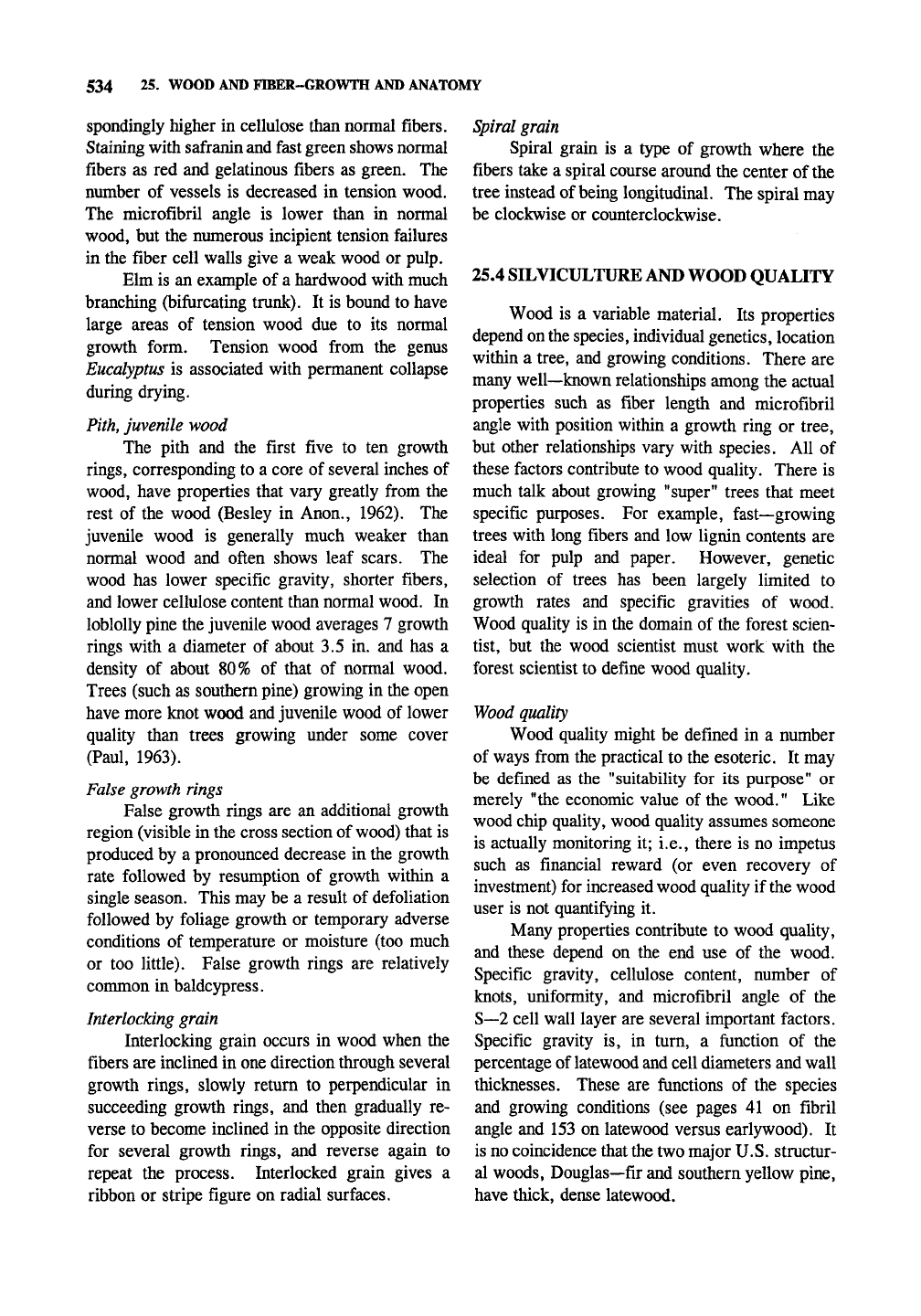
534 25. WOOD AND FIBER-GROWTH AND ANATOMY
spondingly higher in cellulose than normal fibers.
Staining with safranin and fast green shows normal
fibers as red and gelatinous fibers as green. The
number of vessels is decreased in tension wood.
The microfibril angle is lower than in normal
wood, but the numerous incipient tension failures
in the fiber cell walls give a weak wood or pulp.
Elm is an example of a hardwood with much
branching (bifurcating trunk). It is bound to have
large areas of tension wood due to its normal
growth form. Tension wood from the genus
Eucalyptus is associated with permanent collapse
during drying.
Pith,
juvenile wood
The pith and the first five to ten growth
rings,
corresponding to a core of several inches of
wood, have properties that vary greatly from the
rest of the wood (Besley in Anon., 1962). The
juvenile wood is generally much weaker than
normal wood and often shows leaf scars. The
wood has lower specific gravity, shorter fibers,
and lower cellulose content than normal wood. In
loblolly pine the juvenile wood averages 7 growth
rings with a diameter of about 3.5 in. and has a
density of about 80% of that of normal wood.
Trees (such as southern pine) growing in the open
have more knot wood and juvenile wood of lower
quality than trees growing under some cover
(Paul, 1963).
False growth rings
False growth rings are an additional growth
region (visible in the cross section of wood) that is
produced by a pronounced decrease in the growth
rate followed by resumption of growth within a
single season. This may be a result of defoliation
followed by foliage growth or temporary adverse
conditions of temperature or moisture (too much
or too little). False growth rings are relatively
common in baldcypress.
Interlocking grain
Interlocking grain occurs in wood when the
fibers are inclined in one direction through several
growth rings, slowly return to perpendicular in
succeeding growth rings, and then gradually re-
verse to become inclined in the opposite direction
for several growtii rings, and reverse again to
repeat the process. Interlocked grain gives a
ribbon or stripe figure on radial surfaces.
Spiral grain
Spiral grain is a type of growth where the
fibers take a spiral course around the center of the
tree instead of being longitudinal. The spiral may
be clockwise or counterclockwise.
25.4 SILVICULTURE AND WOOD QUALITY
Wood is a variable material. Its properties
depend on
the
species, individual genetics, location
within a tree, and growing conditions. There are
many well—known relationships among the actual
properties such as fiber length and microfibril
angle with position within a growth ring or tree,
but other relationships vary with species. All of
these factors contribute to wood quality. There is
much talk about growing "super" trees that meet
specific purposes. For example, fast—growing
trees with long fibers and low lignin contents are
ideal for pulp and paper. However, genetic
selection of trees has been largely limited to
growth rates and specific gravities of wood.
Wood quality is in the domain of the forest scien-
tist, but the wood scientist must work with the
forest scientist to define wood quality.
Wood quality
Wood quality might be defined in a number
of ways from the practical to the esoteric. It may
be defined as the "suitability for its purpose" or
merely "the economic value of the wood." Like
wood chip quality, wood quality assumes someone
is actually monitoring it; i.e., there is no impetus
such as financial reward (or even recovery of
investment) for increased wood quality if
the
wood
user is not quantifying it.
Many properties contribute to wood quality,
and these depend on the end use of the wood.
Specific gravity, cellulose content, number of
knots,
uniformity, and microfibril angle of the
S—2 cell wall layer are several important factors.
Specific gravity is, in turn, a function of the
percentage of latewood and cell diameters and wall
thicknesses. These are functions of the species
and growing conditions (see pages 41 on fibril
angle and 153 on latewood versus early
wood).
It
is no coincidence that the two major U.S. structur-
al woods, Douglas—fir and southern yellow pine,
have thick, dense latewood.
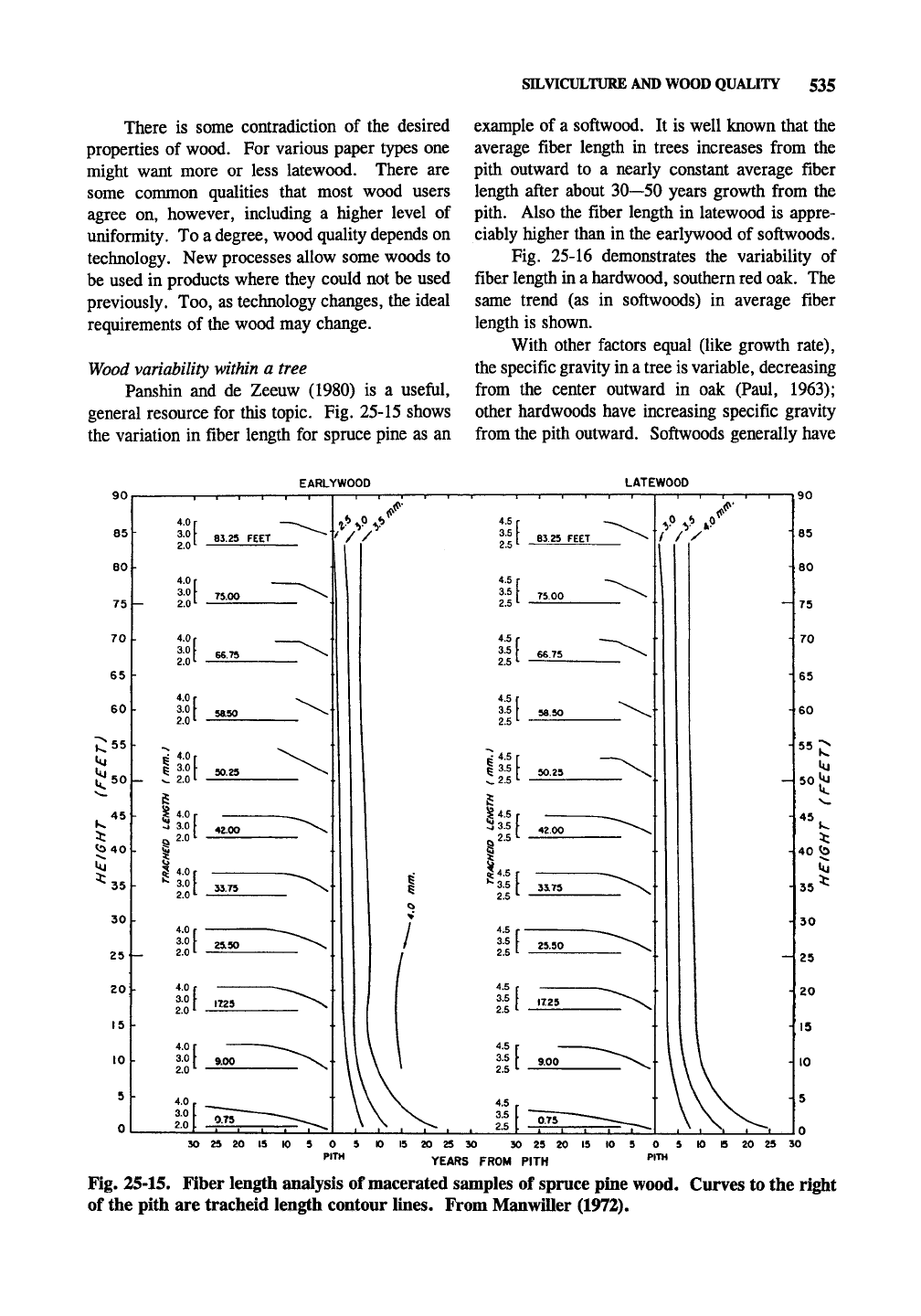
SILVICULTURE AND WOOD QUALITY 535
There is some contradiction of the desired
properties of wood. For various paper types one
might want more or less latewood. There are
some common qualities that most wood users
agree on, however, including a higher level of
uniformity. To a degree, wood quality depends on
technology. New processes allow some woods to
be used in products where they could not be used
previously. Too, as technology changes, the ideal
requirements of the wood may change.
Wood variability within a tree
Panshin and de Zeeuw (1980) is a useful,
general resource for this topic. Fig. 25-15 shows
the variation in fiber length for spruce pine as an
example of a softwood. It is well known that the
average fiber length in trees increases from the
pith outward to a nearly constant average fiber
length after about 30—50 years growth from the
pith. Also the fiber length in latewood is appre-
ciably higher than in the earlywood of softwoods.
Fig. 25-16 demonstrates the variability of
fiber length in a hardwood, southern red oak. The
same trend (as in softwoods) in average fiber
length is shown.
With other factors equal (like growth rate),
the specific gravity in a tree is variable, decreasing
from the center outward in oak (Paul, 1963);
other hardwoods have increasing specific gravity
from the pith outward. Softwoods generally have
90
85
80
75
70
65
60
^55
l:;5o
^ 40
kj
EARLYWOOD
LATEWOOD
35
30
25}-
20
15
10
5
0
2.0 ••
4.0 r
3.0 [
9ni
.oi
,0^
5^ 4.0
i:{3.
2.0 ••
: 4.0 r
= 3.0 50.2
. 2.01
.^.PV^
^^'
4.5 r
3.5
h
[^
4.5
r
3.5 f
4.5 r
3-5 58.50
2.5'-
5 ^-5 [
^3-5[ 50.25
5
-3.5 [ 4200
I
|4.5r
3-5 f 3i75
2.5 '•
4.5 r
2.5
I ^^^Q
90
85
80
75
70
65
460
kj
50^
40
VD
lu
30
25
20
15
10
5
302520 IS K)9 0 5 10 15 202530 30 25 20 15 10 9 0 5 K) 19 20 25 30
YEARS FROM PITH
Fig. 25-15. Fiber length analysis of macerated samples of spruce pine wood. Curves to the right
of the pith are tracheid length contour lines. From Manwiller (1972).
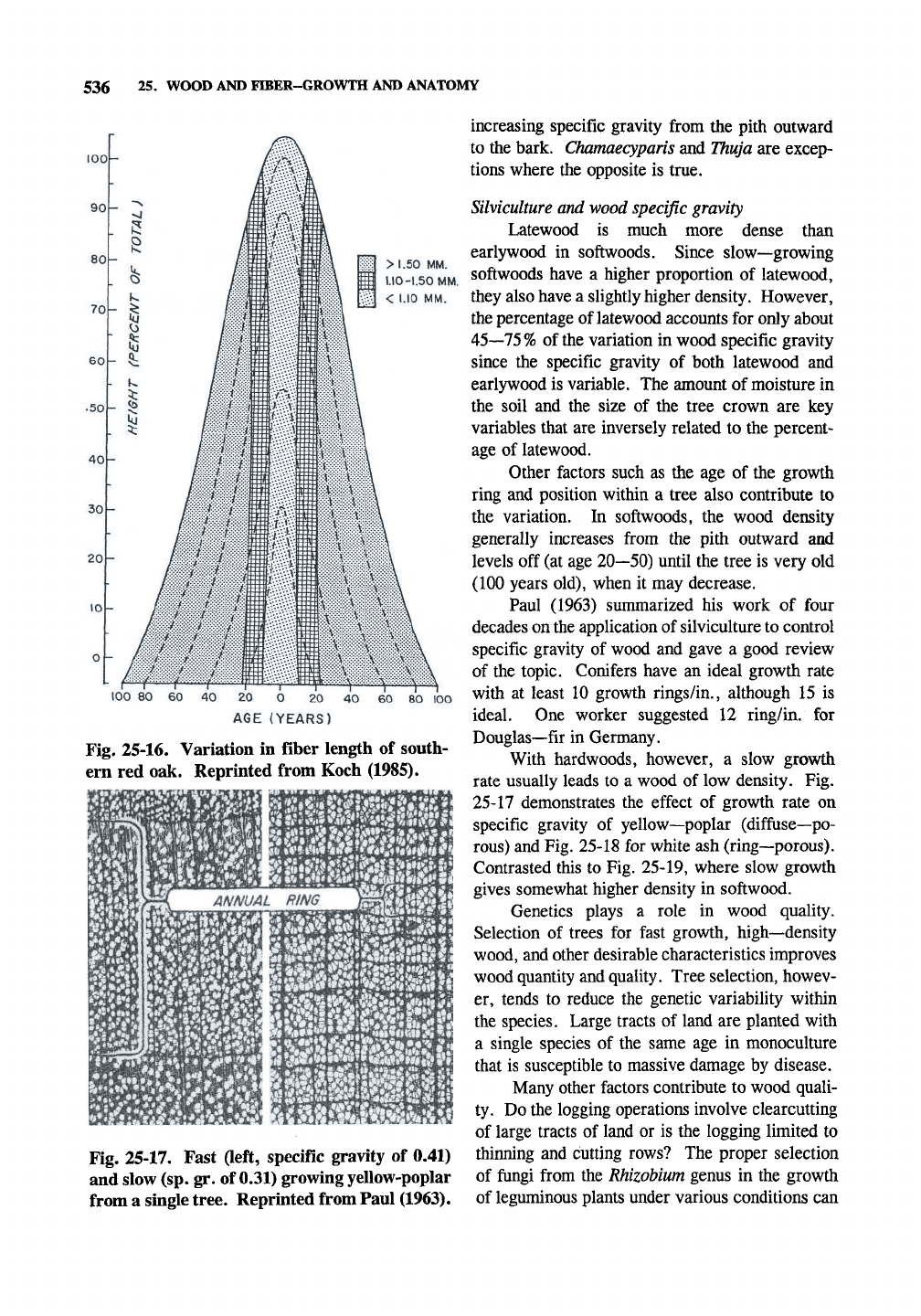
536 25. WOOD AND FTOER-GROWTH AND ANATOMY
100
90
80
70
60
.50^
40
30
20
10
>l.50 MM.
I.I0-I.50
MM.
< I.IO MM.
100 80
40 60 80 100
20 0 20
AGE (YEARS)
Fig. 25-16. Variation in fiber length of south-
ern red oak. Reprinted from Koch (1985).
Fig. 25-17. Fast (left, specific gravity of 0.41)
and slow (sp. gr. of 0.31) growing yellow-poplar
from a single tree. Reprinted from Paul (1963).
increasing specific gravity from the pith outward
to the bark.
Chamaecyparis
and
J?iuja
are excep-
tions where the opposite is true.
Silviculture and wood specific gravity
Latewood is much more dense than
earlywood in softwoods. Since slow—growing
softwoods have a higher proportion of latewood,
they also have a slightly higher density. However,
the percentage of latewood accounts for only about
45—75%
of the variation in wood specific gravity
since the specific gravity of both latewood and
earlywood is variable. The amount of moisture in
the soil and the size of the tree crown are key
variables that are inversely related to the percent-
age of latewood.
Other factors such as the age of the growth
ring and position within a tree also contribute to
the variation. In softwoods, the wood density
generally increases from the pith outward and
levels off (at age 20—50) until the tree is very old
(100 years old), when it may decrease.
Paul (1963) summarized his work of four
decades on the application of silviculture to control
specific gravity of wood and gave a good review
of the topic. Conifers have an ideal growth rate
with at least 10 growth rings/in., although 15 is
ideal. One worker suggested 12 ring/in. for
Douglas—fir in Germany.
With hardwoods, however, a slow growth
rate usually leads to a wood of low density. Fig.
25-17 demonstrates the effect of growth rate on
specific gravity of yellow—poplar (difftise—po-
rous) and Fig. 25-18 for white ash (ring—porous).
Contrasted this to Fig. 25-19, where slow growth
gives somewhat higher density in softwood.
Genetics plays a role in wood quality.
Selection of trees for fast growth, high—density
wood, and other desirable characteristics improves
wood quantity and quality. Tree selection, howev-
er, tends to reduce the genetic variability within
the species. Large tracts of land are planted with
a single species of the same age in monoculture
that is susceptible to massive damage by disease.
Many other factors contribute to wood quali-
ty. Do the logging operations involve clearcutting
of large tracts of land or is the logging limited to
thinning and cutting rows? The proper selection
of fungi from the Rhizobium genus in the growth
of leguminous plants under various conditions can
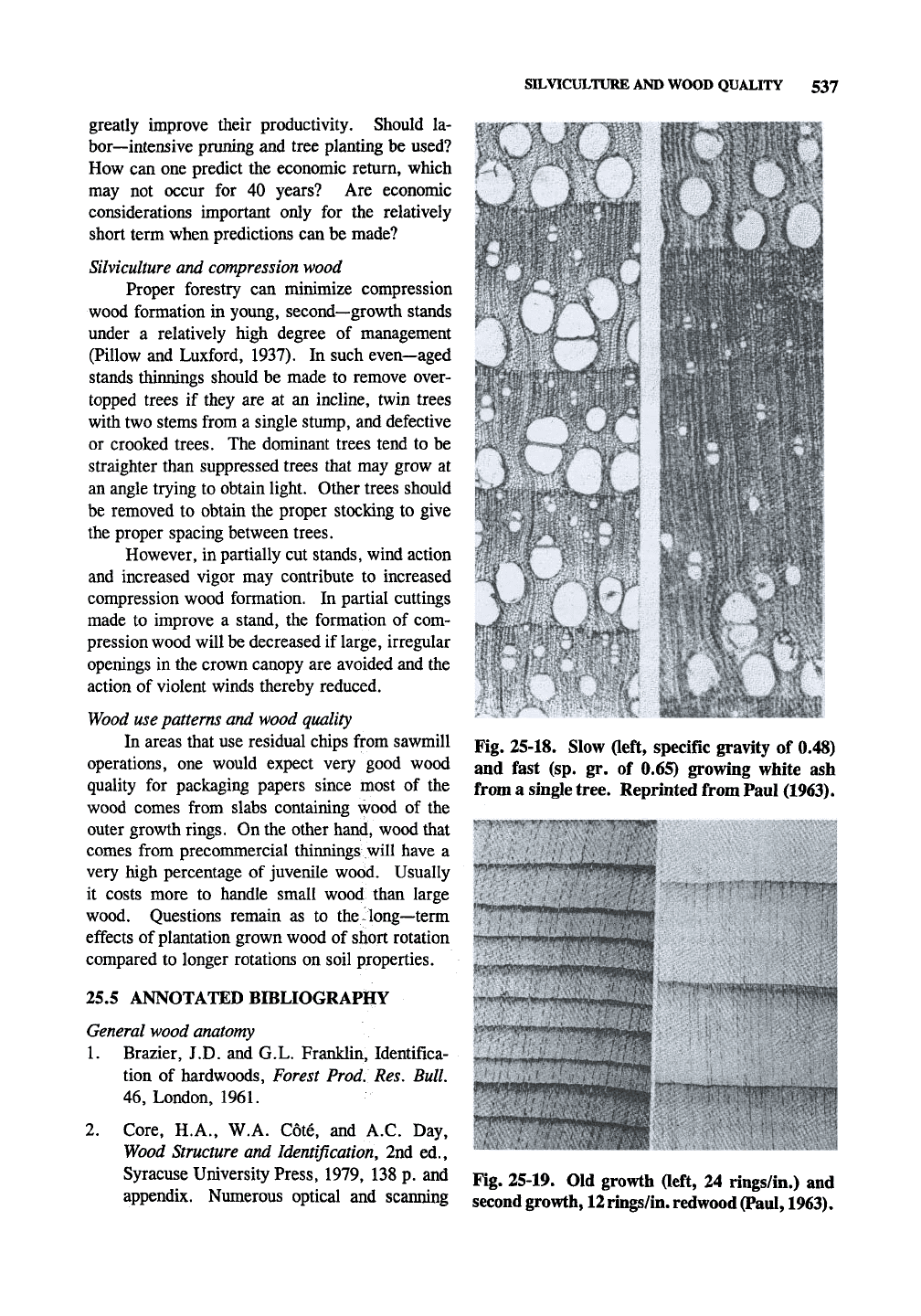
SILVICULTURE AND WOOD QUALITY 537
greatly improve their productivity. Should la-
bor—intensive pruning and tree planting be used?
How can one predict the economic return, which
may not occur for 40 years? Are economic
considerations important only for the relatively
short term when predictions can be made?
Silviculture and compression wood
Proper forestry can minimize compression
wood formation in young, second—growth stands
under a relatively high degree of management
(Pillow and Luxford, 1937). In such even—aged
stands thinnings should be made to remove over-
topped trees if they are at an incline, twin trees
with two stems from a single stump, and defective
or crooked trees. The dominant trees tend to be
straighter than suppressed trees that may grow at
an angle trying to obtain light. Other trees should
be removed to obtain the proper stocking to give
the proper spacing between trees.
However, in partially cut stands, wind action
and increased vigor may contribute to increased
compression wood formation. In partial cuttings
made to improve a stand, the formation of com-
pression wood will be decreased if large, irregular
openings in the crown canopy are avoided and the
action of violent winds thereby reduced.
Wood
use
patterns and wood quality
In areas that use residual chips from sawmill
operations, one would expect very good wood
quality for packaging papers since most of the
wood comes from slabs containing wood of the
outer growth rings. On the other hand, wood that
comes from precommercial thinnings will have a
very high percentage of juvenile wood. Usually
it costs more to handle small wood than large
wood. Questions remain as to the long—term
effects of plantation grown wood of short rotation
compared to longer rotations on soil properties.
25.5 ANNOTATED BIBLIOGRAPHY
General wood anatomy
1.
Brazier, J.D. and G.L. Franklin, Identifica-
tion of hardwoods. Forest
Prod,
Res, Bull
46,
London, 1961.
2.
Core, H.A., W.A. Cote, and A.C. Day,
Wood Structure and Identification, 2nd ed.,
Syracuse University Press, 1979, 138 p. and
appendix. Numerous optical and scanning
Fig. 25-18. Slow Geft, specific gravity of 0.48)
and fast (sp. gr. of 0.65) growing white ash
from a single tree. Reprinted from Paul (1963).
Fig. 25-19. Old growth Oeft, 24 rings/in.) and
second growth,
12
rings/in.
redwood
(Paul,
1963).
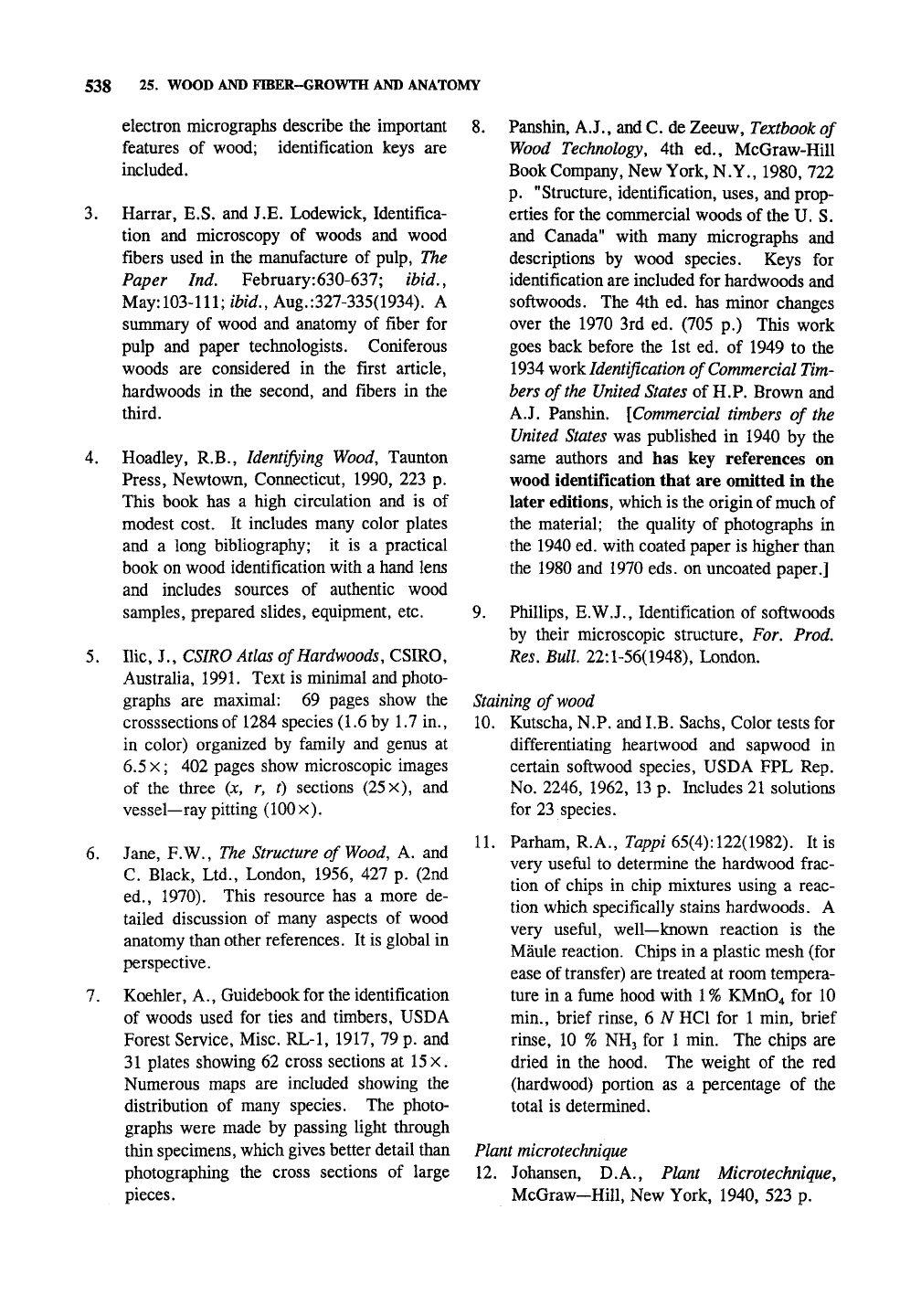
538 25. WOOD AND FIBER-GROWTH AND ANATOMY
electron micrographs describe the important
features of wood; identification keys are
included.
3.
Harrar, E.S. and J.E. Lodewick, Identifica-
tion and microscopy of woods and wood
fibers used in the manufacture of pulp, The
Paper Ind. February:630-637;
ibid.,
May:103-lll;
ibid.,
Aug.:327-335(1934). A
summary of wood and anatomy of fiber for
pulp and paper technologists. Coniferous
woods are considered in the first article,
hardwoods in the second, and fibers in the
third.
4.
Hoadley, R.B., Identifying
Wood,
Taunton
Press,
Newtown, Connecticut, 1990, 223 p.
This book has a high circulation and is of
modest cost. It includes many color plates
and a long bibliography; it is a practical
book on wood identification with a hand lens
and includes sources of authentic wood
samples, prepared slides, equipment, etc.
5.
Ilic, J.,
CSIRO
Atlas of Hardwoods, CSIRO,
Australia, 1991. Text is minimal and photo-
graphs are maximal: 69 pages show the
crosssections of 1284 species (1.6 by 1.7 in.,
in color) organized by family and genus at
6.5 X; 402 pages show microscopic images
of the three (A:, r, t) sections
(25
x), and
vessel—ray pitting (lOOx).
6. Jane, F.W., The Structure of
Wood,
A. and
C. Black, Ltd., London, 1956, 427 p. (2nd
ed., 1970). This resource has a more de-
tailed discussion of many aspects of wood
anatomy than other references. It is global in
perspective.
7.
Koehler, A., Guidebook for the identification
of woods used for ties and timbers, USD A
Forest Service, Misc. RL-1, 1917, 79 p. and
31 plates showing 62 cross sections at
15
x.
Numerous maps are included showing the
distribution of many species. The photo-
graphs were made by passing light through
thin specimens, which gives better detail than
photographing the cross sections of large
pieces.
8. Panshin, A.J., and C. de Zeeuw, Textbook of
Wood Technology, 4th ed., McGraw-Hill
Book Company, New York, N.Y., 1980, 722
p.
"Structure, identification, uses, and prop-
erties for the commercial woods of the U. S.
and Canada" with many micrographs and
descriptions by wood species. Keys for
identification are included for hardwoods and
softwoods. The 4th ed. has minor changes
over the 1970 3rd ed. (705 p.) This work
goes back before the 1st ed. of 1949 to the
1934 work
Identification
of Commercial Tim-
bers of the
United
States of H.P. Brown and
A.J. Panshin. [Commercial timbers of the
United States was published in 1940 by the
same authors and has key references on
wood identification that are omitted in the
later editions, which is the origin of much of
the material; the quality of photographs in
the 1940 ed. with coated paper is higher than
the 1980 and 1970 eds. on uncoated paper.]
9. Phillips, E.W.J., Identification of softwoods
by their microscopic structure. For.
Prod.
Res.
Bull. 22:1-56(1948), London.
Staining of
wood
10.
Kutscha, N.P. and LB. Sachs, Color tests for
differentiating heartwood and sapwood in
certain softwood species, USD A FPL Rep.
No.
2246, 1962, 13 p. Includes 21 solutions
for 23 species.
11.
Parham, R.A., Tflppz
65(4):
122(1982).
It is
very useful to determine the hardwood frac-
tion of chips in chip mixtures using a reac-
tion which specifically stains hardwoods. A
very useful, well—known reaction is the
Maule reaction. Chips in a plastic mesh (for
ease of transfer) are treated at room tempera-
ture in a fume hood with
1 %
KMn04 for 10
min., brief rinse, 6 N HCl for 1 min, brief
rinse, 10 % NH3 for 1 min. The chips are
dried in the hood. The weight of the red
(hardwood) portion as a percentage of the
total is determined.
Plant
microtechnique
12.
Johansen, D.A., Plant Microtechnique,
McGraw-Hill, New York, 1940, 523 p.
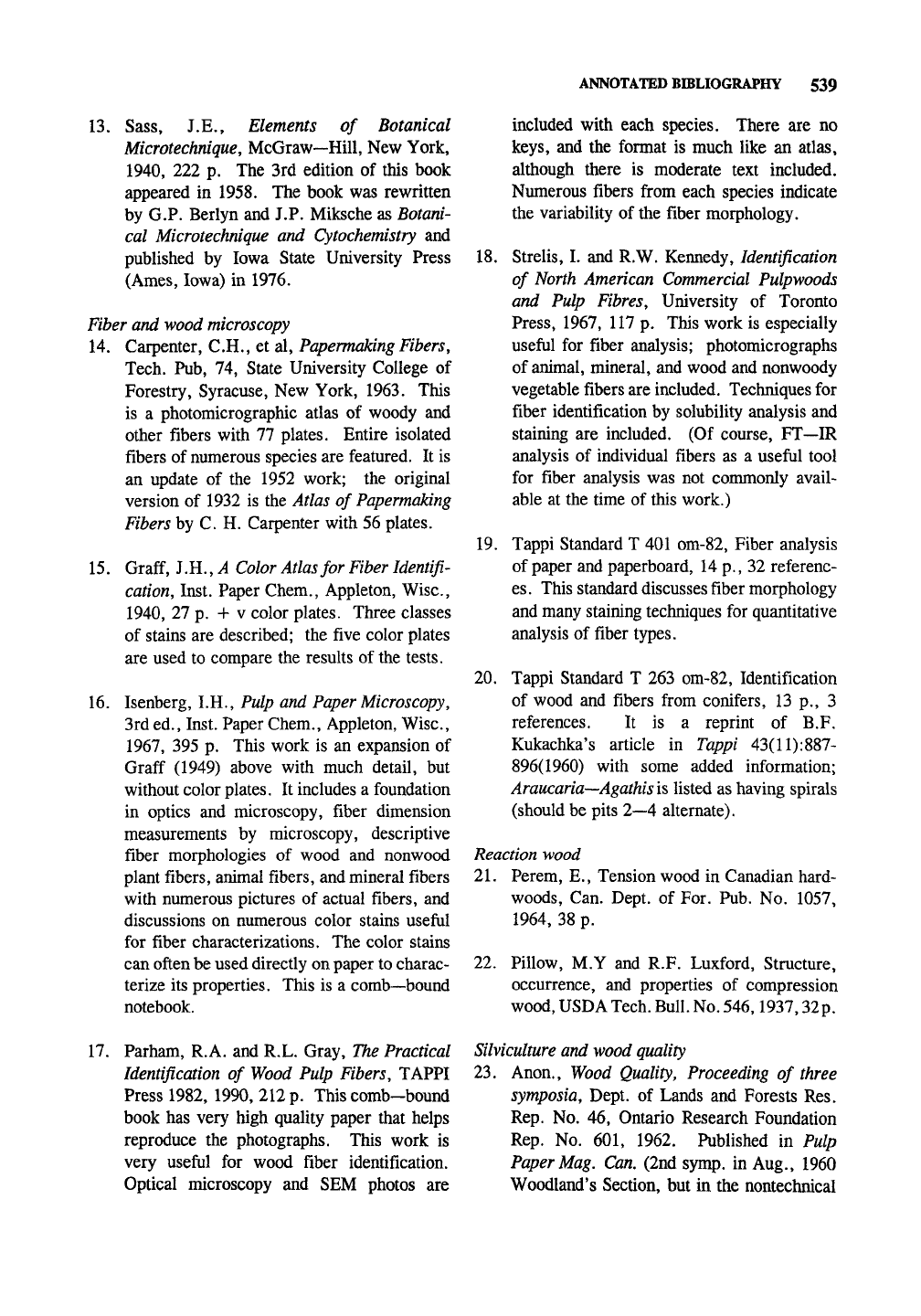
ANNOTATED BIBLIOGRAPHY 539
13.
Sass, J.E., Elements of Botanical
Microtechnique, McGraw-Hill, New York,
1940,
222 p. The 3rd edition of this book
appeared in 1958. The book was rewritten
by G.P. Berlyn and J.P. Miksche as Botani-
cal Microtechnique and Cytochemistry and
published by Iowa State University Press
(Ames, Iowa) in 1976.
Fiber and wood
microscopy
14.
Carpenter, C.H., et al,
Papermaking
Fibers,
Tech. Pub, 74, State University College of
Forestry, Syracuse, New York, 1963. This
is a photomicrographic atlas of woody and
other fibers with 77 plates. Entire isolated
fibers of numerous species are featured. It is
an update of the 1952 work; the original
version of 1932 is the Atlas of
Papermaking
Fibers by C. H. Carpenter with 56 plates.
15.
Graff,
J.H., A
Color
Atlas for
Fiber
Identifi-
cation, Inst. Paper Chem., Appleton, Wise,
1940,
27 p. 4-
V
color plates. Three classes
of stains are described; the five color plates
are used to compare the results of the tests.
16.
Isenberg, I.H., Pulp and Paper Microscopy,
3rd ed., Inst. Paper Chem., Appleton, Wise,
1967,
395 p. This work is an expansion of
Graff (1949) above with much detail, but
without color plates. It includes a foundation
in optics and microscopy, fiber dimension
measurements by microscopy, descriptive
fiber morphologies of wood and nonwood
plant fibers, animal fibers, and mineral fibers
with numerous pictures of actual fibers, and
discussions on numerous color stains useful
for fiber characterizations. The color stains
can often be used directly on paper to charac-
terize its properties. This is a comb—bound
notebook.
17.
Parham, R.A. and R.L. Gray, The Practical
Identification of Wood Pulp Fibers, TAPPI
Press 1982, 1990, 212 p. This comb—bound
book has very high quality paper that helps
reproduce the photographs. This work is
very useful for wood fiber identification.
Optical microscopy and SEM photos are
included with each species. There are no
keys,
and the format is much like an atlas,
although there is moderate text included.
Numerous fibers from each species indicate
the variability of the fiber morphology.
18.
Strelis, I. and R.W. Kennedy, Identification
of North American Commercial Pulpwoods
and Pulp Fibres, University of Toronto
Press,
1967, 117 p. This work is especially
useful for fiber analysis; photomicrographs
of animal, mineral, and wood and nonwoody
vegetable fibers are included. Techniques for
fiber identification by solubility analysis and
staining are included. (Of course, FT—IR
analysis of individual fibers as a useful tool
for fiber analysis was not commonly avail-
able at the time of this work.)
19.
Tappi Standard T 401 om-82, Fiber analysis
of paper and paperboard, 14 p., 32 referenc-
es.
This standard discusses fiber morphology
and many staining techniques for quantitative
analysis of fiber types.
20.
Tappi Standard T 263 om-82, Identification
of wood and fibers from conifers, 13 p., 3
references. It is a reprint of B.F,
Kukachka's article in Tappi 43(11):887-
896(1960) with some added information;
Araucaria—Agathis is
listed as having spirals
(should be pits 2—4 alternate).
Reaction wood
21.
Perem, E., Tension wood in Canadian hard-
woods. Can. Dept. of For. Pub. No. 1057,
1964,
38 p.
22.
Pillow, M.Y and R.F. Luxford, Structure,
occurrence, and properties of compression
wood, USD
A
Tech.
Bull. No. 546,1937,32
p.
Silviculture
and wood
quality
23.
Anon., Wood Quality, Proceeding of three
symposia, Dept. of Lands and Forests Res.
Rep.
No. 46, Ontario Research Foundation
Rep.
No. 601, 1962. Published in Pulp
Paper
Mag.
Can, (2nd symp. in Aug., 1960
Woodland's Section, but in the nontechnical
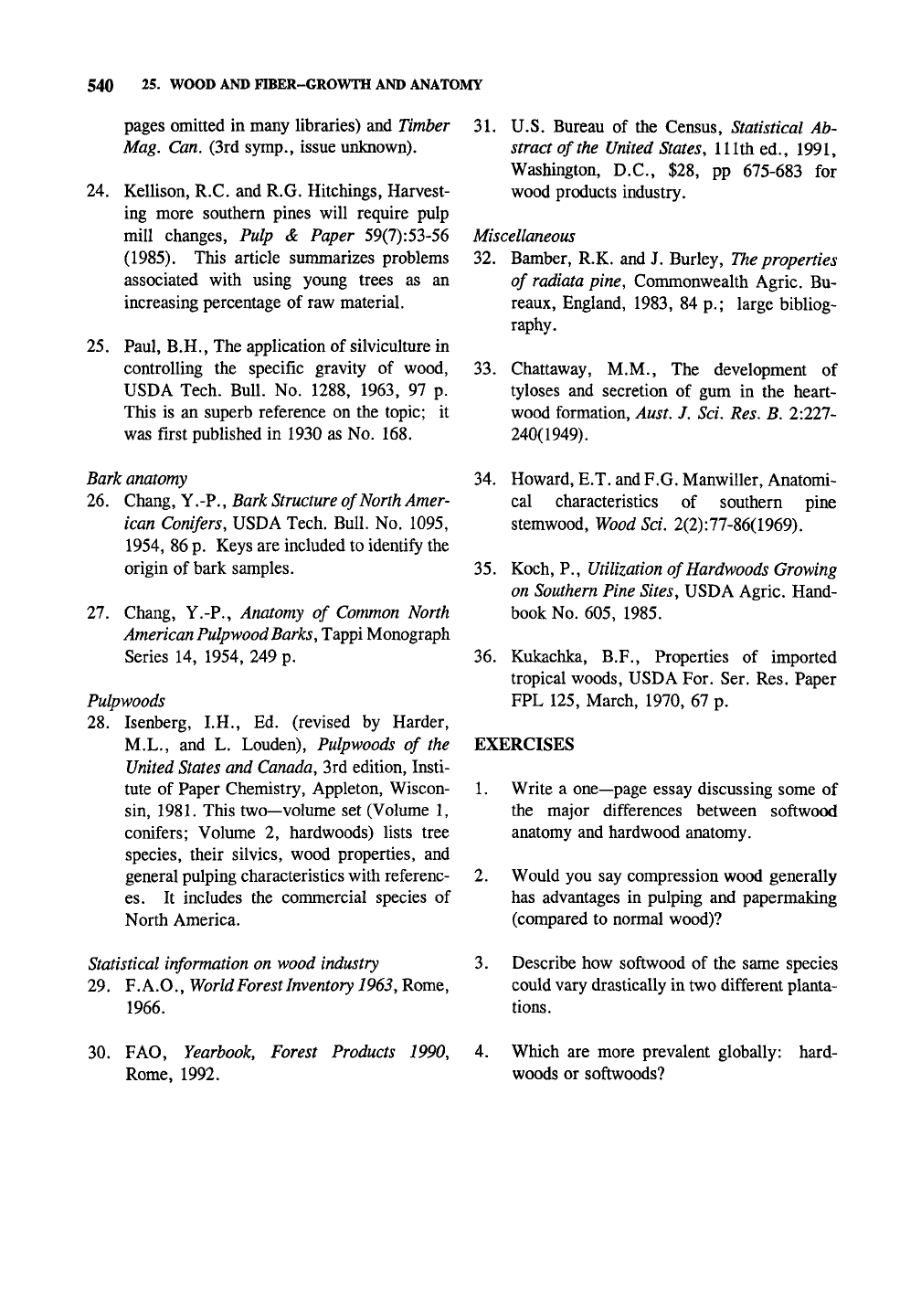
540 25. WOOD AND FIBER-GROWTH AND ANATOMY
pages omitted in many libraries) and Timber
Mag. Can. (3rd symp., issue unknown).
24.
Kellison, R.C. and R.G. Hitchings, Harvest-
ing more southern pines will require pulp
mill changes, Pulp & Paper 59(7):53-56
(1985).
This article summarizes problems
associated with using young trees as an
increasing percentage of raw material.
25.
Paul, B.H., The application of silviculture in
controlling the specific gravity of wood,
USDA Tech. Bull. No. 1288, 1963, 97 p.
This is an superb reference on the topic; it
was first published in 1930 as No. 168.
Bark
anatomy
26.
Chang, Y.-P.,
Bark Structure
of
North
Amer-
ican Conifers, USDA Tech. Bull. No. 1095,
1954,
86 p. Keys are included to identify the
origin of bark samples.
27.
Chang, Y.-P., Anatomy of
Common
North
American
Pulpwood
Barks,
Tappi Monograph
Series 14, 1954, 249 p.
Pulpwoods
28.
Isenberg, I.H., Ed. (revised by Harder,
M.L., and L. Louden), Pulpwoods of the
United States
and
Canada,
3rd edition. Insti-
tute of Paper Chemistry, Appleton, Wiscon-
sin, 1981. This two—volume set (Volume 1,
conifers; Volume 2, hardwoods) lists tree
species, their silvics, wood properties, and
general pulping characteristics with referenc-
es.
It includes the commercial species of
North America.
Statistical
information
on wood
industry
29.
F.
A.O.,
World Forest
Inventory
1963,
Rome,
1966.
31.
U.S. Bureau of the Census, Statistical Ab-
stract of
the
United States, 111th ed., 1991,
Washington, D.C., $28, pp 675-683 for
wood products industry.
Miscellaneous
32.
Bamber, R.K. and J. Burley,
The
properties
of
radiata
pine. Commonwealth Agric. Bu-
reaux, England, 1983, 84 p.; large bibliog-
raphy.
33.
Chattaway, M.M., The development of
tyloses and secretion of gum in the heart-
wood formation,
Aust.
J. Sci. Res. B. I'.lll-
240(1949).
34.
Howard, E.T. and E.G. Manwiller, Anatomi-
cal characteristics of southern pine
stemwood. Wood Sci. 2(2):77-86(1969).
35.
Koch, P.,
Utilization
of Hardwoods Growing
on
Southern
Pine Sites, USDA Agric. Hand-
book No. 605, 1985.
36.
Kukachka, B.F., Properties of imported
tropical woods, USDA Eor. Ser. Res. Paper
FPL 125, March, 1970, 67 p.
EXERCISES
1.
Write a one—page essay discussing some of
the major differences between softwood
anatomy and hardwood anatomy.
2.
Would you say compression wood generally
has advantages in pulping and papermaking
(compared to normal wood)?
3.
Describe how softwood of the same species
could vary drastically in two different planta-
tions.
30.
FAO, Yearbook,
Rome, 1992.
Forest Products 1990, 4. Which are more prevalent globally:
woods or softwoods?
hard-
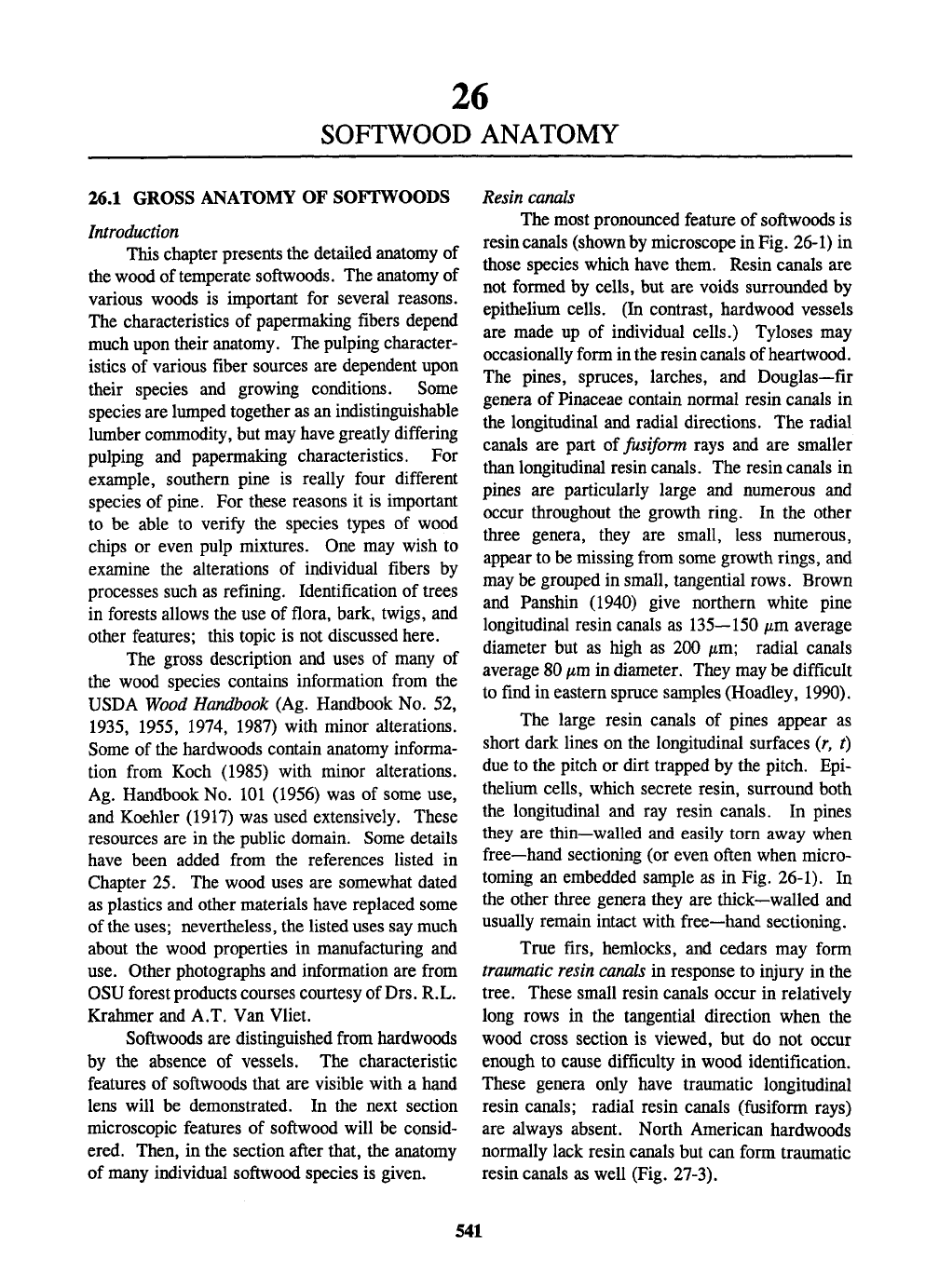
26
SOFTWOOD ANATOMY
26.1 GROSS ANATOMY OF SOFTWOODS
Introduction
This chapter presents the detailed anatomy of
the wood of temperate softwoods. The anatomy of
various woods is important for several reasons.
The characteristics of papermaking fibers depend
much upon their anatomy. The pulping character-
istics of various fiber sources are dependent upon
their species and growing conditions. Some
species are lumped together as an indistinguishable
lumber commodity, but may have greatly differing
pulping and papermaking characteristics. For
example, southern pine is really four different
species of pine. For these reasons it is important
to be able to verify the species types of wood
chips or even pulp mixtures. One may wish to
examine the alterations of individual fibers by
processes such as refining. Identification of trees
in forests allows the use of flora, bark, twigs, and
other features; this topic is not discussed here.
The gross description and uses of many of
the wood species contains information from the
USDA Wood Handbook (Ag. Handbook No. 52,
1935,
1955, 1974, 1987) with minor alterations.
Some of the hardwoods contain anatomy informa-
tion from Koch (1985) with minor alterations.
Ag.
Handbook No. 101 (1956) was of some use,
and Koehler (1917) was used extensively. These
resources are in the public domain. Some details
have been added from the references listed in
Chapter 25. The wood uses are somewhat dated
as plastics and other materials have replaced some
of
the
uses; nevertheless, the listed uses say much
about the wood properties in manufacturing and
use.
Other photographs and information are from
OSU forest products courses courtesy of
Drs.
R.L.
Krahmer and A.T. Van Vliet.
Softwoods are distinguished from hardwoods
by the absence of vessels. The characteristic
features of softwoods that are visible with a hand
lens will be demonstrated. In the next section
microscopic features of softwood will be consid-
ered. Then, in the section after that, the anatomy
of many individual softwood species is given.
Resin canals
The most pronounced feature of softwoods is
resin canals (shown by microscope in Fig. 26-1) in
those species which have them. Resin canals are
not formed by cells, but are voids surroimded by
epithelium cells. (In contrast, hardwood vessels
are made up of individual cells.) Tyloses may
occasionally form in the resin canals of heartwood.
The pines, spruces, larches, and Douglas—fir
genera of Pinaceae contain normal resin canals in
the longitudinal and radial directions. The radial
canals are part of fusiform rays and are smaller
than longitudinal resin
canals.
The resin canals in
pines are particularly large and numerous and
occur throughout the growth ring. In the other
three genera, they are small, less numerous,
appear to be missing from some growth rings, and
may be grouped in small, tangential rows. Brown
and Panshin (1940) give northern white pine
longitudinal resin canals as 135—150 /xm average
diameter but as high as 200 /xm; radial canals
average 80 /xm in diameter. They may be difficult
to find in eastern spruce samples (Hoadley, 1990).
The large resin canals of pines appear as
short dark lines on the longitudinal surfaces (r, t)
due to the pitch or dirt trapped by the pitch. Epi-
thelium cells, which secrete resin, surround both
the longitudinal and ray resin canals. In pines
they are thin—walled and easily torn away when
free—hand sectioning (or even often when micro-
toming an embedded sample as in Fig. 26-1). In
the other three genera they are thick—walled and
usually remain intact with free—hand sectioning.
True firs, hemlocks, and cedars may form
traumatic resin canals in response to injury in the
tree.
These small resin canals occur in relatively
long rows in the tangential direction when the
wood cross section is viewed, but do not occur
enough to cause difficulty in wood identification.
These genera only have traumatic longitudinal
resin canals; radial resin canals (fusiform rays)
are always absent. North American hardwoods
normally lack resin canals but can form traumatic
resin canals as well (Fig. 27-3).
541
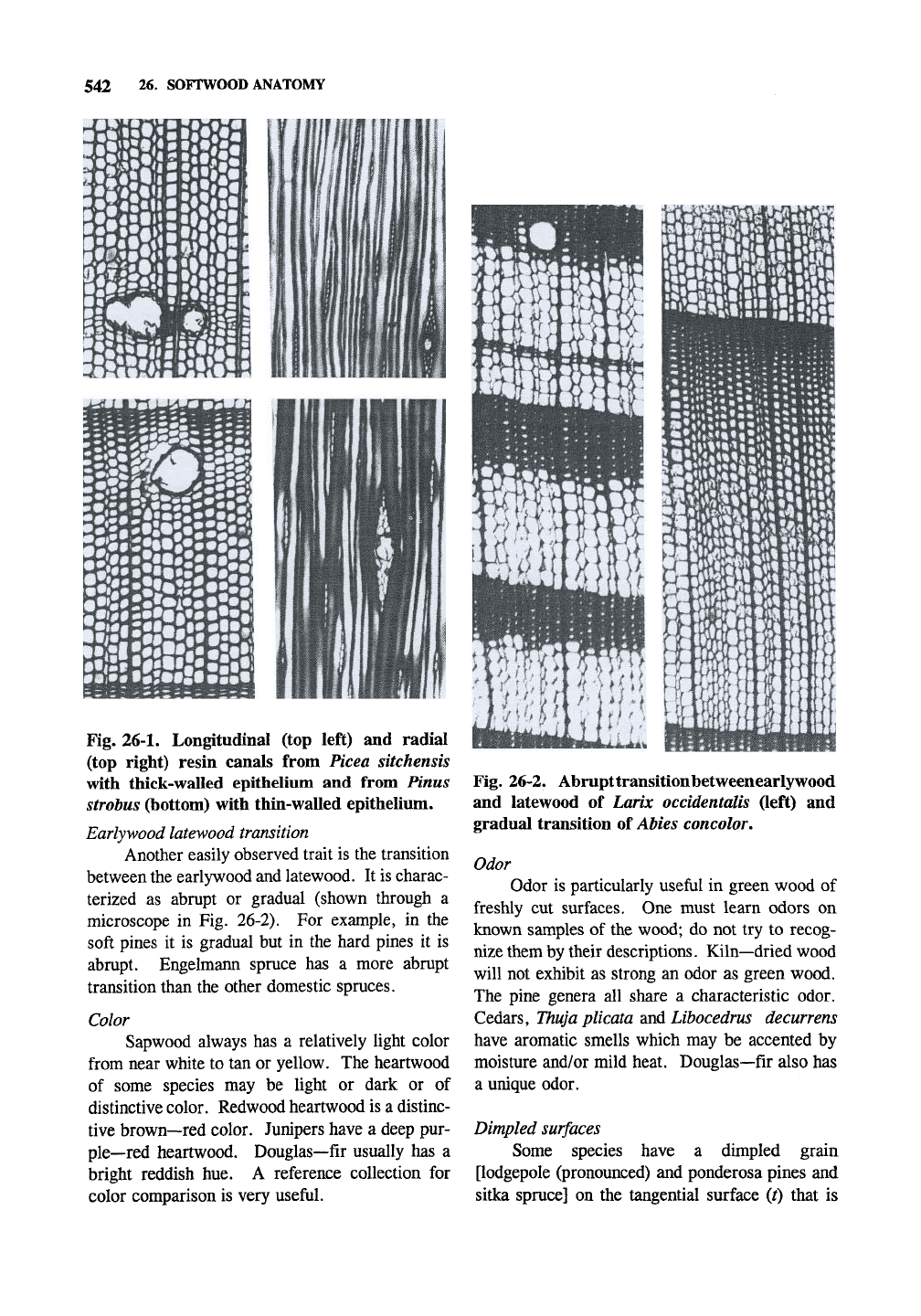
542 26. SOFTWOOD ANATOMY
III
Fig. 26-1. Longitudinal (top left) and radial
(top right) resin canals from Picea sitchensis
with thick-walled epithelium and from Pinus
strobus (bottom) with thin-walled epithelium.
Earlywood latewood transition
Another easily observed trait is the transition
between the earlywood and latewood. It is charac-
terized as abrupt or gradual (shown through a
microscope in Fig. 26-2). For example, in the
soft pines it is gradual but in the hard pines it is
abrupt. Engelmann spruce has a more abrupt
transition than the other domestic spruces.
Color
Sapwood always has a relatively light color
from near white to tan or yellow. The heartwood
of some species may be light or dark or of
distinctive color. Redwood heartwood is a distinc-
tive brown—red color. Junipers have a deep pur-
ple—red heartwood. Douglas—fir usually has a
bright reddish hue. A reference collection for
color comparison is very usefiil.
Fig. 26-2. Abrupttransitionbetweenearlywood
and latewood of Larix occidentalis (left) and
gradual transition of Abies concolor.
Odor
Odor is particularly useful in green wood of
freshly cut surfaces. One must learn odors on
known samples of the wood; do not try to recog-
nize them by their descriptions. Kiln—dried wood
will not exhibit as strong an odor as green wood.
The pine genera all share a characteristic odor.
Cedars,
Thuja
plicata and Libocedrus decurrens
have aromatic smells which may be accented by
moisture and/or mild heat. Douglas—fir also has
a unique odor.
Dimpled surfaces
Some species have a dimpled grain
[lodgepole (pronounced) and ponderosa pines and
sitka spruce] on the tangential surface (t) that is
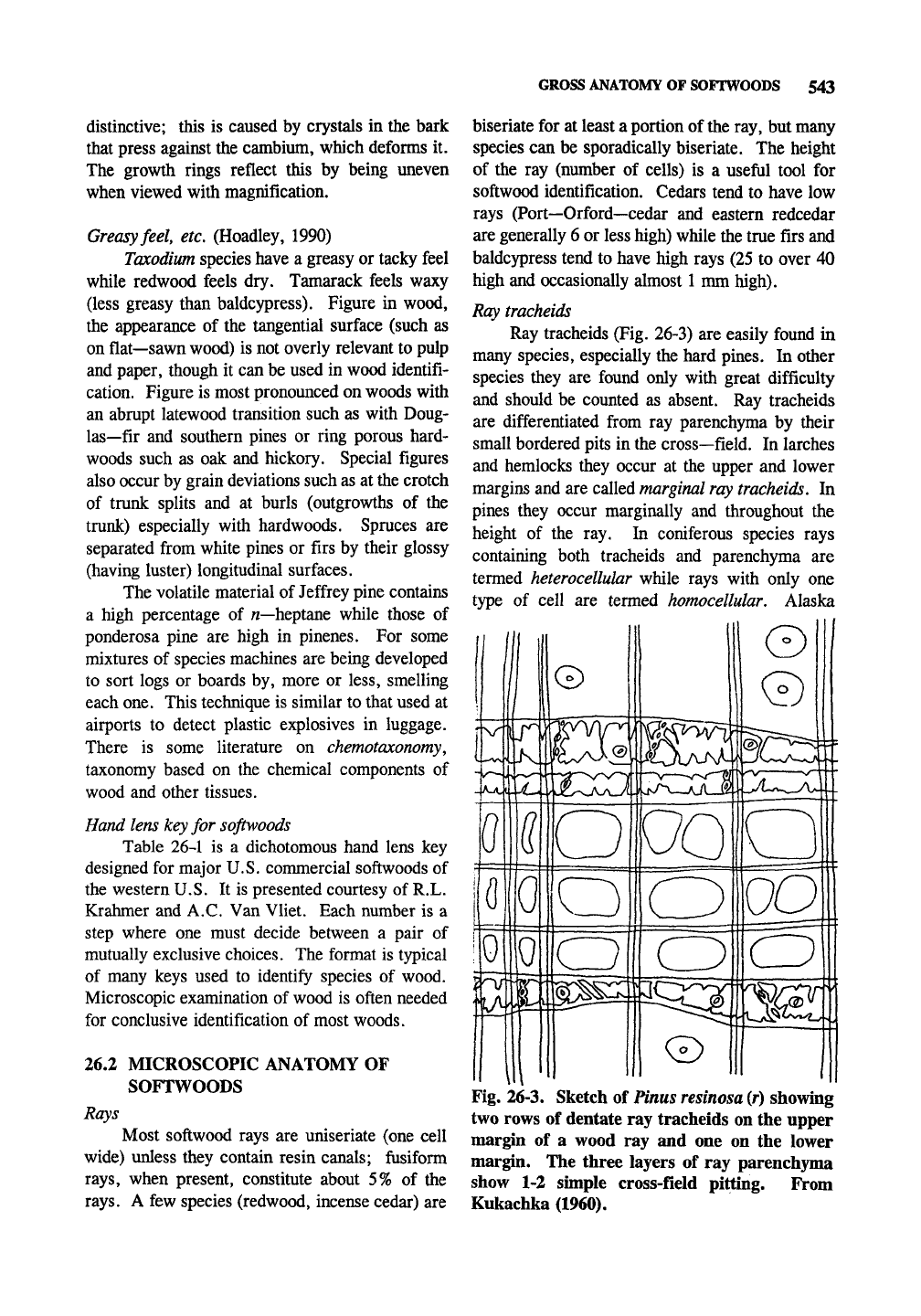
GROSS ANATOMY OF SOFTWOODS 543
distinctive; this is caused by crystals in the bark
that press against the cambium, which deforms it.
The growth rings reflect this by being uneven
when viewed with magnification.
Greasy feel etc. (Hoadley, 1990)
Taxodium species have a greasy or tacky feel
while redwood feels dry. Tamarack feels waxy
(less greasy than baldcypress). Figure in wood,
the appearance of the tangential surface (such as
on
flat—sawn
wood) is not overly relevant to pulp
and paper, though it can be used in wood identifi-
cation. Figure is most pronounced on woods with
an abrupt latewood transition such as with Doug-
las—fir and southern pines or ring porous hard-
woods such as oak and hickory. Special figures
also occur by grain deviations such as at the crotch
of trunk splits and at burls (outgrowths of the
trunk) especially with hardwoods. Spruces are
separated from white pines or firs by their glossy
(having luster) longitudinal surfaces.
The volatile material of Jeffrey pine contains
a high percentage of /z—heptane while those of
ponderosa pine are high in pinenes. For some
mixtures of species machines are being developed
to sort logs or boards by, more or less, smelling
each one. This technique is similar to that used at
airports to detect plastic explosives in luggage.
There is some literature on chemotaxonomy,
taxonomy based on the chemical components of
wood and other tissues.
Hand lens
key
for softwoods
Table 26-1 is a dichotomous hand lens key
designed for major U.S. commercial softwoods of
the western U.S. It is presented courtesy of R.L.
Krahmer and A.C. Van Vliet. Each number is a
step where one must decide between a pair of
mutually exclusive choices. The format is typical
of many keys used to identify species of wood.
Microscopic examination of wood is often needed
for conclusive identification of most woods.
26.2 MICROSCOPIC ANATOMY OF
SOFTWOODS
Rays
Most softwood rays are uniseriate (one cell
wide) unless they contain resin canals; fiisiform
rays,
when present, constitute about 5% of the
rays.
A few species (redwood, incense cedar) are
biseriate for at least a portion of the ray, but many
species can be sporadically biseriate. The height
of the ray (number of cells) is a useful tool for
softwood identification. Cedars tend to have low
rays (Port—Orford—cedar and eastern redcedar
are generally 6 or less high) while the true firs and
baldcypress tend to have high rays (25 to over 40
high and occasionally almost 1 mm high).
Ray tracheids
Ray tracheids (Fig. 26-3) are easily found in
many species, especially the hard pines. In other
species they are found only with great difficulty
and should be counted as absent. Ray tracheids
are differentiated from ray parenchyma by their
small bordered pits in the cross—field. In larches
and hemlocks they occur at the upper and lower
margins and are called marginal ray tracheids. In
pines they occur marginally and throughout the
height of the ray. In coniferous species rays
containing both tracheids and parenchyma are
termed heterocellular while rays with only one
type of cell are termed homocellular. Alaska
Fig. 26-3. Sketch of Pinus resinosa
(r)
showing
two rows of dentate ray tracheids on the upper
margin of a wood ray and one on the lower
margin. The three layers of ray parenchyma
show 1-2 simple cross-field pitting. From
Kukachka (1960).
